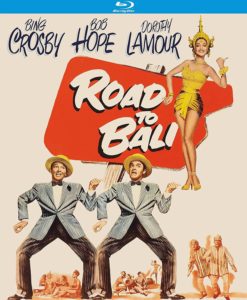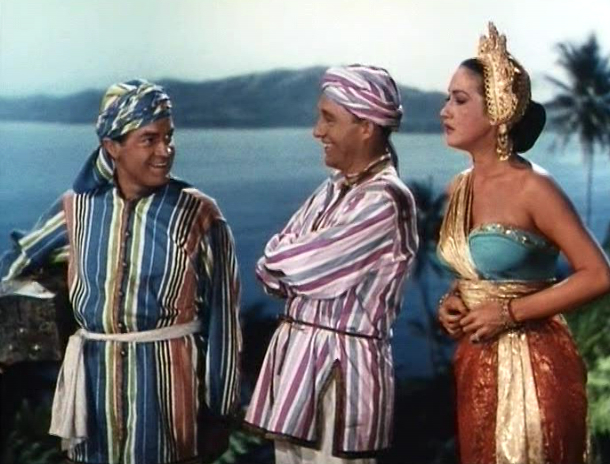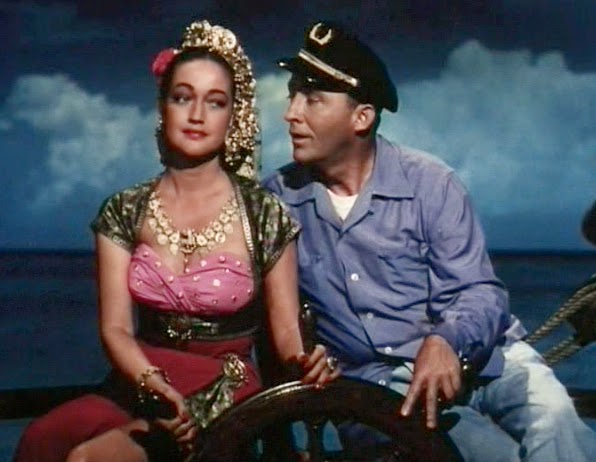Bob Hope, Bing Crosby and Dorothy Lamour are on the Road Again – in Living Color!
DIRECTED BY HAL WALKER/1952
STREET DATE: JULY 05, 2017, KINO LORBER STUDIO CLASSICS
 “I’ve never seen a Road picture.”
“I’ve never seen a Road picture.”
“What?!? How could you have never in your life seen a Road picture?”
“I never have.”
Thus went my introduction to the Bob Hope/Bing Crosby series of comedically ridiculous pseudo-travelogue films. The conversation wasn’t mine. I merely heard it while listening to a local old fart radio show. From their tone, I could tell this was unthinkable, a glaring movie omission. For men of their age.
And there I was, well into my twenties, thinking myself a well-rounded cinephile, never having heard of the series. I thought I was rather well-versed in “film franchises”.
Then I remembered something. Bob Hope, once upon a time, was actually a popular movie star. A fact practically unknown by so many under the age of, say seventy these days. And Bing Crosby… didn’t he record a Christmas album…?
Shortly thereafter, the DVD explosion of the late ’90s did more to expand my horizons, such as they were. Suddenly, there were new leases on life for the dusty work of these venerable old timers.
The Road movies were back in circulation. I’d read reviews of the discs to try to get the gist of what the old farts on the radio were talking about. And for a while, that was good enough. Until now.

(l-r) Bob Hope, Bing Crosby and Dorothy Lamour in ROAD TO BALI
As part of Kino Lorber Studio Classics’ mini-flurry of Bob Hope titles on Blu-Ray (informally referred to as “Know Hope Month” here at ZekeFilm), The Road to Bali (and its follow-up, The Road to Hong Kong) are washing ashore in high def.
Road to Bali thoroughly defied any expectations I harbored. It is in no way slow, stodgy or cornpone. It is, however, gloriously corny and quick witted to the hilt.
Obviously, I’m not the guy to present a comprehensive look at the series, nor prattle on about how this particular entry, the sixth in the seven film cycle, fits in to the overall series. I come at this a near novice, a total stooge (as opposed to a Marxist, nor, if you will, a “Hopeful”… What’s name can I make up for Laurel & Hardy fans…? “Lardys”?) not only have I never seen a Road picture, I’ve barely, if ever, seen any Bob Hope picture.
But, here I go anyway: In this movie, Hope and Crosby reprise their famous personas (though for whatever reason, different characters) for more misadventures in an exotic, foreign locale. The series is basically these two entertainment titans of their time goofing off together in the name of box office gold. They’re slumming it – they know or, we know it, they know that we know know it – and no one cares, we just have fun. High art cinema, this ain’t.

“He’s gonna sing, folks. Now’s the time to go out and get the popcorn.”
The third star of the series, the glamorous Dorothy Lamour, known for playing island beauties a-plenty, is also along (and saronged) for most of the film, while at the same time as sidelined by the plot as her presence is in this review. (Typical, and unfortunately in keeping with her treatment behind the scenes.)
In true Road movie fashion, perhaps even more so, the film is merely an excuse for Hope and Crosby to get into crazy pickles while chasing skirts and wallowing in hopelessly dated referential humor. In this case, the roaming pair are run out of their jobs as vaudeville entertainers only to wind up taking work as deep sea divers in Bali.
Thinking they’ve landed in the lap of luxury – beautiful girls, tropical surroundings, a sure gig – only to discover they’re patsies having signed up for certain death. Except, they survive (spoiler alert?), and thus concludes the only real intelligible storyline of Road to Bali, roughly thirty minutes in. The rest is a lot of running around, throwing one another under the bus, groaners galore and general silliness.

There are more cameos than ever before, including everyone from Jane Russell (referencing Son of Paleface, a film she’d just done with Bob Hope) to Martin and Lewis to Bing Crosby’s younger brother. Even Humphrey Bogart briefly shows up, ala leftover footage from The African Queen. It’s a whole lot of obviously inexpensive studio-bound nonsense, a string of gags that happily know no bounds in terms of quality control. In keeping with his trademark delivery, Hope provides numerous parenthetical asides to the camera, regularly breaking fourth wall. (Eat your heart out, Deadpool.) (But Groucho Marx deserves some credit.)
So that’s my obligatory film critic info-dump, I do hope you enjoyed it. Aren’t commentary tracks a wonderful thing? Most of the above content I learned from listening to Film Historians Michael Schlesinger and Mark Evanier on their newly recorded audio track, though there’s plenty more of their show biz tales remaining for you to discover. Schlesinger, a KL Studio Classics commentary regular, is always a welcome voice. Evanier, though, is a terrific treat to have along. With a career spanning across all kinds of entertainment, ranging from Saturday morning cartoons to the comics series Groo the Wanderer, he has no shortage of anecdotes and yes, a few quips of his own. A lot of what’s discussed is pretty “in the weeds”, at times going as far as resembling an old fart radio show. But it’s the right track for this film, for sure.
Road to Bali thoroughly defied any expectations I harbored. It is in no way slow, stodgy or cornpone. It is, however, gloriously corny and quick witted to the hilt. And colorful – Road to Bali is the only film of the six in color, a fact that director Hal Walker takes full advantage of. This new Blu-Ray edition displays the vintage vibrancy wonderfully, as well as allowing us to revel in every cost-cutting oversight on display (wires that shouldn’t be there, multiple shadows on supposed exterior locales, etc. All part of the fun, if you ask me.)
Maybe it’s my eleven-plus years as a dad that’s softened my palate for this many “dad jokes”, but I laughed quite a bit. Who knows, maybe I’ll be hitting the road for more Road pictures; down the road, of course. Old farts may pass in the wind, but in the meantime, such old school celebrity nonsense sure can be a gas.
The images in this review are not representative of the actual Blu-ray’s image quality, and are included only to represent the film itself.

